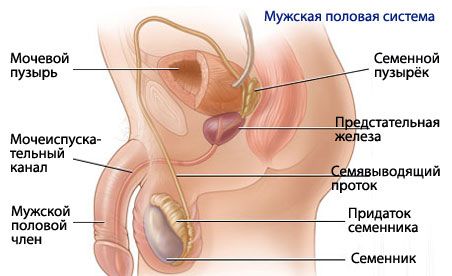Medical expert of the article
New publications
Anatomy and physiology of the male reproductive system
Last reviewed: 04.07.2025

All iLive content is medically reviewed or fact checked to ensure as much factual accuracy as possible.
We have strict sourcing guidelines and only link to reputable media sites, academic research institutions and, whenever possible, medically peer reviewed studies. Note that the numbers in parentheses ([1], [2], etc.) are clickable links to these studies.
If you feel that any of our content is inaccurate, out-of-date, or otherwise questionable, please select it and press Ctrl + Enter.
The human body is a complex system that modern engineers have not yet been able to even simply copy (except in the movies - various cyborgs that more or less resemble people). And the male genitourinary system deserves a separate discussion.
What is so remarkable about this system? Mainly because the small and soft penis of a man when relaxed becomes hard and almost doubles in size when excited, despite the fact that there are no bones in it (unlike some animals). This increase is called an erection.

The internal male genital organs include the testicles with appendages, vas deferens, seminal vesicles, prostate and bulbourethral glands, and the external organs include the penis and scrotum. The length of the genitals varies from 5 to 15 cm in a "resting" state and up to 15 cm or more in an erect state. The penis is formed mainly by blood vessels surrounded and supported by connective tissue and is covered with skin. Inside there are three elastic, tissue-like, porous longitudinal strands (two cavernous bodies and a spongy body) surrounded by connective tissue, which, when filled with arterial blood, increase in size and provide an erection. The urethra passes through the central part of the spongy body. The spongy body ends in the head of the penis, surrounded by a movable fold of skin - the foreskin.
During sexual arousal, the most sensitive areas are the head, frenulum (lower part of the foreskin) and skin, which contains many nerve endings.
In order for the erection process to occur without any problems, several conditions must be met. Firstly, the brain and spinal cord responsible for the signal about the need for an erection must function normally. In other words, the man must be capable of sexual arousal. Secondly, there must be no obstacles in the way of transmitting this impulse (the integrity of the conductive pathways - nerves). Thirdly, the cardiovascular system must function normally, ensuring that the cavernous bodies are filled with blood.
Males have two testicles, one of which is larger than the other. Sperm is produced in the seminiferous tubules, and the interstitial Leydig cells produce the hormone testosterone. From puberty, sex cells, spermatocytes, begin to form; they are formed throughout life. Hundreds of millions of spermatozoa are formed from the cells in the walls of the seminiferous tubules during the maturation cycle. Their maturation process lasts 2-3 months. Sertoli cells of the tissue of the seminiferous tubules secrete a certain amount of fluid. Maturing spermatozoa move along the tubules to the epididymis (a long, wriggling tube), through which they pass for a period of 2 to 4 weeks. In the tail (end) of the epididymis, sperm is stored until ejaculation, then either leaks into the urine or dies.
Sperm formation is promoted by follicle-stimulating hormone and testosterone (forms and maintains secondary male characteristics and stimulates growth).
The following major glands function in the male reproductive tract:
- prostate;
- seminal vesicles;
- bulbourethral (Cowper's) glands.
The prostate gland completely encloses the urethra with its capsule, which consists of smooth muscle fibers. Its enlargement, especially in chronic inflammatory processes and benign tumors (adenomas) in elderly people, can significantly complicate urination and make it extremely painful, etc.
Thus, seminal fluid (sperm) is a mixture of secretions:
- 60-70% of it consists of secretions from the seminal vesicles (a sticky yellowish mass);
- about 20% - prostate gland secretions.
During ejaculation, about 3-4 ml of sperm is released, of which about 2% is true sperm, containing about 300 million spermatozoa (100 million/ml). If their number decreases to 20-40 million/ml, then the chances of successful fertilization of the female egg are minimal.
It should be clarified that under the influence of sexual arousal, upon reaching the peak of sexual tension, an unusually sweet stage simultaneously (normally) occurs - orgasm:
- contraction of the smooth muscles of the vas deferens, seminal vesicles and prostate gland leads to the release of secretions into the urethra (emission stage);
- Seminal fluid is ejected from the urethra due to contractions of the striated muscles located at the base of the penis (ejaculation stage).
At the same time, the internal sphincter of the bladder closes and the external sphincter relaxes.


 [
[